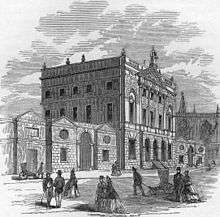Guildhall, Bath
The Guildhall is a municipal building in Bath, Somerset, England. It is a Grade I listed building.[1]
| The Guildhall | |
|---|---|
 | |
| Location | Bath, Somerset, England |
| Coordinates | 51°22′55″N 2°21′32″W |
| Built | 1775 |
| Architect | Thomas Baldwin |
Listed Building – Grade I | |
| Designated | 12 June, 1950[1] |
| Reference no. | 442118 |
 Location of The Guildhall in Somerset | |
History
The earliest mention of the original medieval guildhall was in 1359.[2] This was replaced a Jacobean Guildhall, built on approximately the same site, in 1625.[3] It was considerably enlarged to a design by William Killigrew in 1725 and a series of specially commissioned paintings by Jan Baptist van Diest were subsequently put on display.[3]
The current Bath stone building, which was designed by Thomas Baldwin, was built between 1775 and 1778.[1] It was extended by John McKean Brydon in 1893.[1] The central facade has four Ionic columns and the building is surmounted by the figure of Justice. The central dome and the north and south wings were added in 1893[1] and form a continuous building with the Victoria Art Gallery which was also built around the same time.[4]
The Guildhall suffered considerable damage in a fire on 25 April 1972.[5] The interior includes a banqueting hall with engaged Corinthian columns. It contains 18th century chandeliers and original royal portraits. The room is used on royal visits to the city: Queen Elizabeth II who had lunch in the banqueting room in May 2002.[6]
The building now houses the council chamber for Bath and North East Somerset Council and the Register office for Bath and North East Somerset; the building is also used as a wedding venue, and the record office also houses the Bath and North East Somerset Archives and Local Studies services.[7][8][9] The Guildhall also serves as one of the venues for the Bath International Music Festival and other cultural events. It has been used for filming period dramas.[10]
Bath Guildhall Market
Bath Guildhall Market is located behind the Guildhall, and can be accessed by its own entrance tunnel through the Guildhall. It has traded on its site for the last 800 years. About 20 stall holders trade there nowadays.[11]
Gallery
 The Guildhall in 1864 before the extensions were built
The Guildhall in 1864 before the extensions were built The Guildhall circa 1895
The Guildhall circa 1895 Council Chamber
Council Chamber Alkmaar Room
Alkmaar Room- Neoclassic frieze (John Brydon, architect)
References
- Historic England. "Guildhall, Bath and North East Somerset (1396021)". National Heritage List for England. Retrieved 2017-12-07.
- Holland, Elizabeth (1988). Bath History (PDF). 2. Sutton Publishing. p. 166. ISBN 978-0862995089.
- Fawcett, Trevor. "The Stuart Guildhall". Bath Past. Retrieved 2009-07-25.
- Historic England. "Victoria Art Gallery and Library (1394957)". National Heritage List for England. Retrieved 24 September 2009.
- "The fire at the Guildhall Market 25 April 1972". Bath in Time. Retrieved 26 August 2019.
- "Banqueting room". Bath's Historic Buildings. Bath and North East Somerset Council. Retrieved 2009-07-25.
- "The Guildhall in Bath". Bath's Historic Buildings. Bath and North East Somerset Council. Retrieved 2009-07-25.
- "Marriages in the Guildhall". Bath's Historic Buildings. Bath and North East Somerset Council. Archived from the original on 2010-10-19. Retrieved 2010-10-15.
- "Getting Here: Bath Record Office". Bath Archives and Local Studies. Bath and North East Somerset Council. Retrieved 2017-12-07.
- "Council Chamber". Bath's Historic Buildings. Bath and North East Somerset Council. Retrieved 2009-07-25.
- "Guildhall Market". visitBath. Retrieved 13 November 2015.